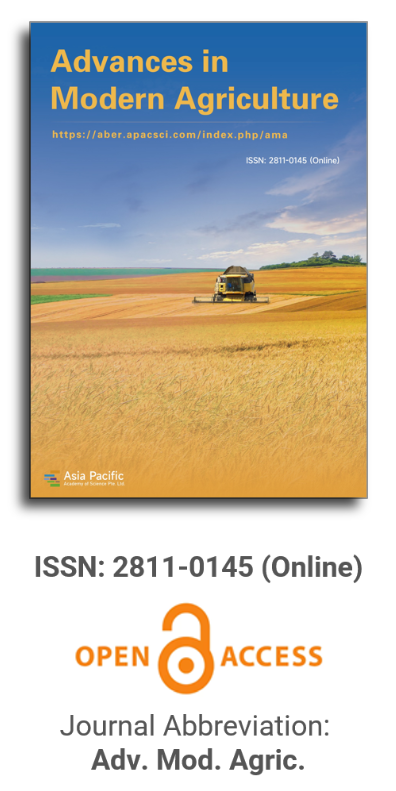


Proposed water valuation scheme for a more sustainable agricultural water productivity
Vol 6, Issue 1, 2025
VIEWS - 1141 (Abstract)
Download PDF
Abstract
Growing depletion of groundwater resources is a global threat and intensified under improper water valuation systems. Here, we proposed an irrigation water valuation framework based on the opportunity cost concept (IWVF), to better differentiate the value of surface water, renewable, and nonrenewable groundwater. In this study, a 10-years dataset was used in Marvdasht-Kharameh irrigation networks (MKINs) in southern Iran, where groundwater depletion overshoots the sustainable level with an annual average rate of 1.42 m y−1. Irrigation water use, net incomes and losses, and economic water productivities (EWP) were estimated under the common and newly developed valuation methods. The reflections of adopting IWVF on EWPs were assessed under current condition and the proposed WP improvement scenarios, including removing irrigation efficiency gaps, changing the cropping calendar, and application of different levels of deficit irrigation. Results showed that the value of irrigation water supply ($436.91 million) exceeds gross income through crop production ($139.01 million) under current condition, which results in a net loss of $297.9 million in the study area. Hence, economic WP loss will be −0.33 $ m−3, meaning that consuming a unit of blue water causes $0.33 income loss under current condition. Applying WP improvement scenarios can reduce value of irrigation water by 27%, and gross income by 5.3%. Accordingly, common WP can increase by 6.6% from 1.81 to 1.93 kg m−3. However, the negative sign of EWP loss under management scenarios (−0.22 $ m−3) indicates that crop production in the study area is not viable due to its considerable environmental damages. Hence, current irrigation system should be revisited when sustainable agriculture is considered. The proposed water valuation method can help decision makers to better assess the consequences of WP improvement strategies, if the true value of different water resources is ignored.
Keywords
References
- Wei X, Bailey RT. Evaluating nitrate and phosphorus remediation in intensively irrigated stream-aquifer systems using a coupled flow and reactive transport model. Journal of Hydrology. 2021; 598: 126304. doi: 10.1016/j.jhydrol.2021.126304
- Hojjati MH, and Boustani F. An assessment of groundwater crisis in Iran case study: Fars province. International Journal of Humanities and Social Science. 2010.
- Salehi S, Chizari M, Sadighi H, et al. Assessment of agricultural groundwater users in Iran: a cultural environmental bias. Hydrogeology Journal. 2017; 26(1): 285-295. doi: 10.1007/s10040-017-1634-9
- Raja O, Parsinejad M, and Sohrabi T. Evaluation of management strategies to reduce water use in Marvdasht-Kharameh study area (Persian). Journal of Water Soil Resour. Prot. 2018.
- Tabari H, Nikbakht J, Shifteh Some’e B. Investigation of groundwater level fluctuations in the north of Iran. Environmental Earth Sciences. 2011; 66(1): 231-243. doi: 10.1007/s12665-011-1229-z
- Voss KA, Famiglietti JS, Lo M, et al. Groundwater depletion in the Middle East from GRACE with implications for transboundary water management in the Tigris‐Euphrates‐Western Iran region. Water Resources Research. 2013; 49(2): 904-914. doi: 10.1002/wrcr.20078
- Masoudi M, Afrough E. 2011. Analyzing trends of precipitation for humid, normal and drought classes using Standardized Precipitation Index (SPI), a case of study: Fars Province, Iran. International Journal of Agricultural Science. 2011.
- Emadodin I, Narita D, Bork HR. Soil degradation and agricultural sustainability: an overview from Iran. Environment, Development and Sustainability. 2012; 14(5): 611-625. doi: 10.1007/s10668-012-9351-y
- Khaledian Y, Kiani F, Ebrahimi S. The effect of land use change on soil and water quality in northern Iran. Journal of Mountain Science. 2012; 9(6): 798-816. doi: 10.1007/s11629-012-2301-1
- Jeihouni M, Toomanian A, Alavipanah SK, et al. Long term groundwater balance and water quality monitoring in the eastern plains of Urmia Lake, Iran: A novel GIS based low cost approach. Journal of African Earth Sciences. 2018; 147: 11-19. doi: 10.1016/j.jafrearsci.2018.06.017
- Pourmohammadali B, Hosseinifard SJ, Hassan Salehi M, et al. Effects of soil properties, water quality and management practices on pistachio yield in Rafsanjan region, southeast of Iran. Agricultural Water Management. 2019; 213: 894-902. doi: 10.1016/j.agwat.2018.12.005
- Renger M, Wessolek G, Schwärzel K, et al. 2002. Aspects of peat conservation and water management. Journal of Plant Nutrition and Soil Science. 2002.
- Zimmermann I, Fleige H, Horn R. Longtime effects of deep groundwater extraction management on water table levels in surface aquifers. Journal of Soils and Sediments. 2016; 17(1): 133-143. doi: 10.1007/s11368-016-1489-z
- Safavi HR, Darzi F, Mariño MA. Simulation-Optimization Modeling of Conjunctive Use of Surface Water and Groundwater. Water Resources Management. 2009; 24(10): 1965-1988. doi: 10.1007/s11269-009-9533-z
- Renault D, Wallender WW. Nutritional water productivity and diets. Agric. Water Manag; 2000.
- Song Z, Peng Y, Li Z, et al. Two irrigation events can achieve relatively high, stable corn yield and water productivity in aeolian sandy soil of northeast China. Agricultural Water Management. 2022; 260: 107291. doi: 10.1016/j.agwat.2021.107291
- Sun G, Hu T, Liu X, et al. Optimizing irrigation and fertilization at various growth stages to improve mango yield, fruit quality and water-fertilizer use efficiency in xerothermic regions. Agricultural Water Management. 2022; 260: 107296. doi: 10.1016/j.agwat.2021.107296
- Léllis BC, Martínez-Romero A, Schwartz RC, et al. Effect of the optimized regulated deficit irrigation methodology on water use in garlic. Agricultural Water Management. 2022; 260: 107280. doi: 10.1016/j.agwat.2021.107280
- Zhang Q, Wang S, Sun Y, et al. Conservation tillage improves soil water storage, spring maize (Zea mays L.) yield and WUE in two types of seasonal rainfall distributions. Soil and Tillage Research. 2022; 215: 105237. doi: 10.1016/j.still.2021.105237
- D’Odorico P, Chiarelli DD, Rosa L, et al. The global value of water in agriculture. Proceedings of the National Academy of Sciences. 2020; 117(36): 21985-21993. doi: 10.1073/pnas.2005835117
- Dupont DP, Adamowicz WL. Water valuation. In Water Policy and Governance in Canada. Springer International Publishing; 2017. doi: 10.1007/978-3-319-42806-2
- Ashayeri MS, Khaledian MR, Kavoosi-Kalashami M, et al. The economic value of irrigation water in paddy farms categorized according to mechanization levels in Guilan province, Iran. Agricultural Water Management. 2018; 202: 195-201. doi: 10.1016/j.agwat.2018.02.014
- Young KS. Psychology of Computer Use: XL. Addictive Use of the Internet: A Case That Breaks the Stereotype. Psychological Reports. 1996; 79(3): 899-902. doi: 10.2466/pr0.1996.79.3.899
- Perry CJ, Kite G. Water accounting at basin scale: a critique of the AQUASTAT approach. 2003; Unpublished Report.
- Saleth RM, Dinar A. Institutional changes in global water sector: trends, patterns, and implications. Water Policy; 2000.
- Julius D, Alicbusan AP. 1989. Public sector pricing policies: a review of Bank policy and practice. Pol. Res. Work. Paper Ser; 1989.
- Johansson RC, Tsur Y, Roe TL, et al. Pricing irrigation water: a review of theory and practice. Water policy; 2002.
- Kloezen WH. Accounting for water: institutional viability and impacts of market-oriented irrigation interventions in central Mexico. Wageningen University and Research.; 2002.
- Eldeeb H, Zelenakova M. Assessment of the economic value of irrigation water considering achieve main crops self-sufficiency: Case study Sharkia Governorate, Egypt. Selected Scientific Papers - Journal of Civil Engineering. 2019; 14(2): 39-50. doi: 10.1515/sspjce-2019-0016
- Ren Y, Wei S, Cheng K, et al. Valuation and Pricing of Agricultural Irrigation Water Based on Macro and Micro Scales. Water. 2018; 10(8): 1044. doi: 10.3390/w10081044
- Al-Karablieh EK, Salman AZ, Al-Omari AS, et al. Estimation of the economic value of irrigation water in Jordan. Journal of Agricultural Science and Technology. 2012.
- Bierkens MFP, Reinhard S, de Bruijn JA, et al. The Shadow Price of Irrigation Water in Major Groundwater‐Depleting Countries. Water Resources Research. 2019; 55(5): 4266-4287. doi: 10.1029/2018wr023086
- Stein S. Opportunity Cost of Water in the South Platte River; Comparing Economic Value Derived from Stated and Revealed Preferences [PhD thesis]. Colorado State University; 2019.
- Zhang J, Zhao T, Jiang C, et al. Opportunity cost of water allocation to afforestation rather than conservation of natural vegetation in China. Land Use Policy. 2016; 50: 67-73. doi: 10.1016/j.landusepol.2015.09.008
- Inglesi-Lotz R, Blignaut J. Estimating the opportunity cost of water for the Kusile and Medupi coal-fired electricity power plants in South Africa. Journal of Energy in Southern Africa. 2012; 23(4): 76-84. doi: 10.17159/2413-3051/2012/v23i4a3180
- Kelman J, Kelman R. Water Allocation for Economic Production in a Semi-arid Region. International Journal of Water Resources Development. 2002; 18(3): 391-407. doi: 10.1080/0790062022000006899
- Persson E, Tinghög G. Opportunity cost neglect in public policy. Journal of Economic Behavior & Organization. 2020; 170: 301-312. doi: 10.1016/j.jebo.2019.12.012
- Farsab Sanat Consulting Engineers. Studies on updating the water resources of the watershed of Tashk-Bakhtegan and Maharloo seafloor, Marvdasht-Karameh study area report (Persian). The Ministry of Energy; 2010
- Raja, O., 2018. The Accounting and sustainable use of water resources in agriculture (Case study: Tashk - Bakhtegan and Maharloo Catchment area) (Persian) [Master’s thesis]. University of Tehran; 2018.
- Ministry of Agriculture-Jahad. Guaranteed price list of crops (Persian). https://en.trend.az/business/economy/3480114.html; 2021.
- Karandish F. Socioeconomic benefits of conserving Iran’s water resources through modifying agricultural practices and water management strategies. Ambio. 2021; 50(10): 1824-1840. doi: 10.1007/s13280-021-01534-w
- First Consulting Engineers Company. Report on the financial and economic justification plan for the transfer of Persian Gulf water to the industries of the southeast of the country (Persian). Unpublished Report; 2017.
- Raja O, Parsinejad M. Cost-effective strategies to improve crop water productivity—case study: Bakhtegan and Maharloo, Iran. International Journal of Environmental Science and Technology. 2022; 20(1): 883-894. doi: 10.1007/s13762-022-04602-0
Supporting Agencies
University of Tehran
Copyright (c) 2025 Khashayar Peyghan, Omid Raja, Masoud Parsinejad, Fatemeh Karandish
License URL: https://creativecommons.org/licenses/by/4.0/

This site is licensed under a Creative Commons Attribution 4.0 International License (CC BY 4.0).

Prof. Zhengjun Qiu
Zhejiang University, China

Cheng Sun
Academician of World Academy of Productivity Science; Executive Chairman, World Confederation of Productivity Science China Chapter, China
Indexing & Archiving
In the realm of modern agriculture, the integration of cutting-edge technologies is revolutionizing the way we approach sustainable farming practices. A recent study published in Advances in Modern Agriculture titled "Classification of cotton water stress using convolutional neural networks and UAV-based RGB imagery" has garnered significant attention for its innovative approach to precision irrigation management. Conducted by researchers from Institute of Data Science and the AgriLife Research and Extension Center of Texas A&M University (authors's information is below). This study introduces a novel method for classifying cotton water stress using unmanned aerial vehicles (UAVs) and convolutional neural networks (CNNs), offering a powerful solution for optimizing water use in agriculture.
Modern agricultural technology is evolving rapidly, with scientists collaborating with leading agricultural enterprises to develop intelligent management practices. These practices utilize advanced systems that provide tailored fertilization and treatment options for large-scale land management.
This journal values human initiative and intelligence, and the employment of AI technologies to write papers that replace the human mind is expressly prohibited. When there is a suspicious submission that uses AI tools to quickly piece together and generate research results, the editorial board of the journal will reject the article, and all journals under the publisher's umbrella will prohibit all authors from submitting their articles.
Readers and authors are asked to exercise caution and strictly adhere to the journal's policy regarding the usage of Artificial Intelligence Generated Content (AIGC) tools.
Asia Pacific Academy of Science Pte. Ltd. (APACSCI) specializes in international journal publishing. APACSCI adopts the open access publishing model and provides an important communication bridge for academic groups whose interest fields include engineering, technology, medicine, computer, mathematics, agriculture and forestry, and environment.



.jpg)
.jpg)

.jpg)
